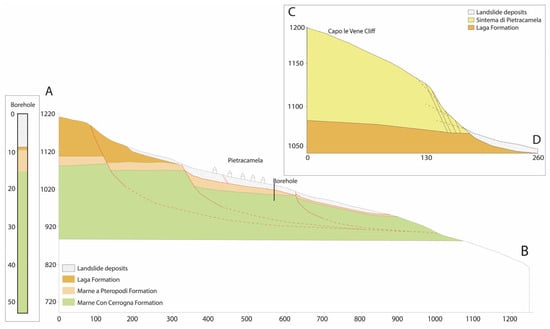Abstract
Landslides represent a major problem in human activities, especially in the proximity of cities or infrastructure. In this paper, we present the peculiar case of Pietracamela, Italy. Pietracamela is a small village located in the Central Apennines, a few kilometers north of the Gran Sasso Mountain. The peculiarity of the case study is the fact that the village is simultaneously affected by two different types of slope instabilities. The southwest sector, representing the historical part of the village, has been affected by large rockfalls generated from the “Capo le Vene” cliff located in the south of the village. The northeastern sector of the village represents the most recent urbanized area and is involved in a deep-seated landslide that, in the last decades, has damaged buildings and infrastructure. In this context, we have used two different types of remote sensing techniques to study the two phenomena. The rockfall area has been surveyed through the use of an Unmanned Aerial Vehicle (UAV) that allowed the definition of main joint sets and the volume of blocks associated with the most recent (2011) rockfall event. Three main joint sets have been highlighted, which are responsible for the failure of the “Capo le Vene” cliff. The volume of blocks that failed during the last rock failure in 2011 ranged from a few to 1500 m3. The deep-seated landslide has been studied by analyzing borehole data and 20 years of InSAR data from ERS1/2, ENVISAT, COSMO-SkyMed, and SENTINEL-1. It has been highlighted by InSAR analysis that the northeast sector of the village shows a perfectly linear displacement trend that generates movements up to about 230 mm (about 1 cm/year).
1. Introduction
Landslides represent a major hazard in many countries around the world, often resulting in significant loss of life and extensive damage to infrastructure. Effects on people and settlements are controlled by landslide intensity, modulated by velocity and mobilized volume, and the number and characteristics of exposed elements []. While landslide velocity is generally related to the mechanism of movement and rheology of the involved material and its potential change during its evolution [,,], landslide geometry and volume are controlled by the geologic setting of a slope [,,]. As a consequence, for a comprehensive hazard assessment related to landslide development, an analysis of the ongoing kinematics, including factors controlling movement and the geologic characteristics of the unstable slope, is always required.
Landslide studies are often based on both field and remote sensing data and stability analysis. The choice of a specific stability analysis and/or remote sensing technique, however, may be related to the type of landslide (kinematics) and its velocity. For example, in the case of very fast events like rockfalls and avalanches, back-estimates from numerical modeling are often the only way to obtain insights into velocity distribution and failure-controlling factors. When dealing with slow-moving and deep-seated landslides, the combined use of monitoring techniques and borehole data becomes fundamental. Several authors have demonstrated the use of different survey and analysis techniques for the study of both fast and slow-moving phenomena.
For example, the use of proximal sensing for the study of rockfall trajectories and landslide kinematics has been recently demonstrated by He et al. [], Calio et al. [], Mammoliti et al. [], Markus et al. [], and Morelli et al. []. Also, the potential of using remote-sensing-based monitoring techniques and subsurface data interpretation for the analysis of the kinematics and anatomy of deep-seated landslides has been pointed out by a number of authors. For instance, Brückl et al. [] used a combination of data derived from photogrammetric, GPS, and geophysical surveys to explain the kinematics of a deep-seated landslide located near Döllach in Austria. Frattini et al. [] used PS-InSAR to unravel the kinematics of deep-seated landslides in the central Alps of northern Italy. Pappalardo et al. [] used infrared thermography and DInSAR techniques to decipher the state and the distribution of activity of the Randazzo landslide in northeastern Sicily. Di Martire et al. [] used a Differential Interferometric Synthetic Aperture Radar (DInSAR) technique to identify and decipher the kinematics of Deep-Seated Gravitational Slope Deformations. Guerriero et al. [] used the digital image correlation of Google Earth imagery to derive the displacement distribution of a selected landslide and glacier, demonstrating that low-cost solutions can be used for characterizing and monitoring landslide movements. Notti et al. [] used a multidisciplinary approach consisting of field surveys, satellite DInSAR time series analyses, digital image correlation techniques, rainfall records analyses, postevent monitoring campaigns, subsurface investigation data analyses, and numerical modeling to analyze the behavior of the Monesi di Mendatica landslide in the Ligurian Alps. Samsonov and Blais-Stevens [] used DInSAR-derived 2D and constrained 3D deformation rates to estimate the volume of large, slow-moving, deep-seated landslides in northern Canada. The reconstruction of the geologic setting of a slope to decipher landslide controls requires knowledge of both lithological features of rocks and discontinuity measurements, as well as landslide geometry, deformational feature distribution, and state of activity [,,]. Under specific geologic settings, landslides can form complexes or associations that can have a much more severe impact than a single event and can require differentiated mitigation measurements and strategies [,,,]. In such contexts, a combined analysis oriented to the definition of predisposing geologic characteristics of unstable slopes and landslide kinematics is of basic importance in the definition of hazards and, eventually, risk scenarios.
On this basis, in this paper, the peculiar case of the Pietracamela village in the Abruzzo region of central Italy has been analyzed with the aim of deciphering landslide mechanisms and kinematics and identifying potential controlling factors. This case study is of particular significance since the southwest (SW) sector of the village, representing the historical center, has been affected by a large rockfall while the northeast (NE) sector, representing the most recent urbanization, has been developed on a deep-seated roto-translation landslide [] that is slowly damaging buildings and infrastructure. The most recent significant rockfall event documented in the SW sector occurred in March 2011, when large blocks detached from the “Capo le Vene” cliff, arriving in the proximity of the village buildings. Regarding the deep-seated landslide affecting the NE sector, also documented by Centamore et al. [], this has been studied over the years through the use of boreholes and inclinometers (now dismissed) up to 160 m deep.
In this context, we propose a multidisciplinary approach based on the use of different surveys and remote sensing sensors, which enable the study of two completely different types of failures, i.e., deep-seated landslides and rockfalls.
Rockfall potential and kinematics have been analyzed through the use of an Unmanned Aerial Vehicle (UAV) photogrammetry-derived point cloud and field surveys.
The deep-seated landslide geometry, kinematics, and controlling factors have been analyzed on the basis of available geological/borehole data, field surveys, and Differential Interferometric Synthetic Aperture Radar (DInSAR) data.
Through the combination of different survey and analysis techniques, it was possible to determine the potentially hazardous areas that can be affected by both slow, deep-seated movements and fast rockfalls. Special emphasis will be given to the importance of using different satellite data (from ERS1/2, ENVISAT, COSMO-SkyMed, and SENTINEL-1) for improving the understanding of deep-seated landslide behavior in the last 20 years. The presented approach could be replicated by both scholars and practitioners in the definition of hazardous areas.
2. Study Area
Pietracamela is located in the Abruzzi Region (province of Teramo), a few kilometers north of the Gran Sasso Mountain (Central Apennines). The small village is at an altitude of 1005 m a.s.l. and, with a population of ca 250, it has been included in the list of the most beautiful hamlets in Italy. Pietracamela is divided into two sectors by the ”Fosso Rio la Porta” stream (Figure 1). The SW part of the village is the oldest (historians place its origins in the 15th century) and was mostly abandoned after strong earthquakes occurred between 1950 and 1952. The NE part has been built more recently and represents the new village of Pietracamela.
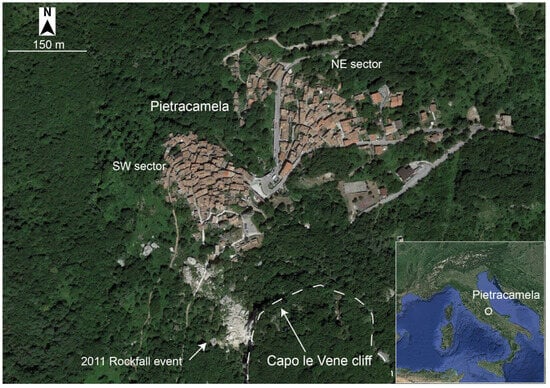
Figure 1.
Location of the Pietracamela village with highlighted the NE and SW sectors and the 2011 rockfall event. Google Erath image.
From the geological point of view, the area is the result of a chain–foredeep–foreland system, started in the Miocene with the convergence of the European and African Plate [,,,,,]. Such an orogenic phase was subsequently followed by an extensional phase. During the Pleistocene, the gradual uplift that has characterized the Apennines created the conditions for the deposition of colluvial deposits, large landslide deposits, and thick sedimentary sequences, which filled the structural depression formed during the extensional phase [,]. In particular, three main formations crop out in the study area. The oldest in age is the “Marne con Cerrogna” Formation (Burdigalian–Tortonian), characterized by marl and marly limestone. The Marne con Cerrogna Formation is overlaid by a ca 20–30 m thick layer of Marne a Pteropodi Formations, represented by marls and clayey marls. On the top of the Marne a Pteropodi, we can find the alternating clay and sandstone layers of the “Laga” Formation (Messinian). The most recent formation characterizing the area is represented by the well-cemented breccia of the “Sintema di Pietracamela” (Middle Pleistocene), which forms the “Capo le Vene” cliff, impending over the SW sector of the village (Figure 1). Holocene colluvial deposits and landslide deposits widely outcrop in the area, overlaying the oldest formations. The geological map of the study area is reported in Figure 2.
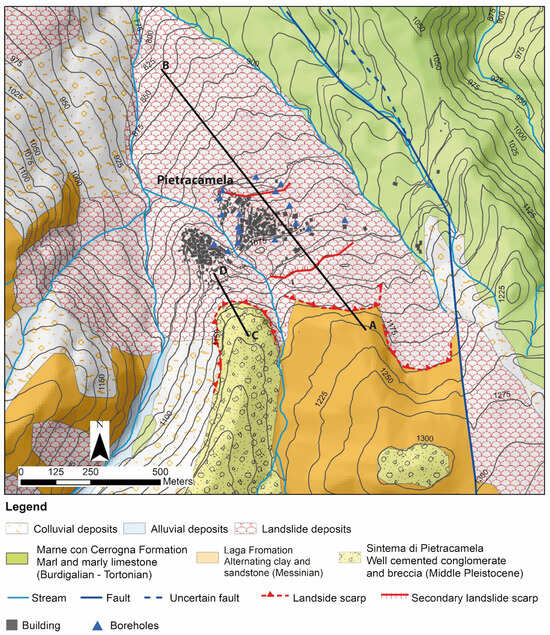
Figure 2.
Geological map of the study area.
3. Materials and Methods
This study has been carried out by integrating multiple field and remote sensing techniques. Unmanned Aerial Vehicle (UAV) and rockfall simulation have been used to understand potential future rockfall scenarios in the SW sector of the village, while Interferometric Synthetic Aperture Radar (InSAR) and borehole data have been used to understand the behavior and mechanism characterizing the deep-seated failure affecting the NE sector of Pietracamela.
3.1. Field Borehole Analysis
Field geological and engineering–geological surveys and borehole analysis have been carried out to improve our understanding of the geological, structural, and geomechanical settings of the area. Boreholes have been drilled over different periods, from the 1990s up to recent years. The location of boreholes is highlighted in Figure 2. Stratigraphically, they show the presence of eluvial–colluvial and landslide deposits in the first few meters (usually around 3 m). Below these deposits, the Laga formation is present, with a thickness of ca. 25/30 m. Between the Laga Formation and the bedrock (characterized by the “Marne con Cerrogna” Formation), we find a 20 to 30 m thick layer of the Marne a Pteropodi Formation. The main movements, measured by an inclinometer installed during the 90s and now dismissed, reported displacements at ca 30/40 m in depth (at the contact between the Laga Formation and the clayey layer of the Marne a Pteropodi) and up to 160 m of depth within the “Marne con Cerrogna” Formation.
The well-cemented conglomerates and breccias of the Sintema di Pietracamela, which represents the youngest formation, characterize the “Capo le Vene Cliff,” a relief that borders the south and southeastern sides of the village. This area was studied through geomechanical analyses of rockmassES.
3.2. UAV Surveys and Geomechanical Analyses
Due to the inaccessibility of most of the outcrops at the bottom of the “Capo le Vene” cliff, the use of UAVs played a key role in the definition of geological/geomechanical features and block volumes. We carried out the UAV survey through a Mavic 2 Pro vehicle. Two different surveys (and flight plans) were defined to cover the whole area of interest. During the first survey, we acquired 120 (nadiral) aerial photographs at an elevation of 120 m from the ground, while, through the second flight, we gathered an additional 118 side photographs of the “Capo le Vene” cliff (keeping a distance from the cliff of ca 50–70 m). Overlap and sidelap between the photographs were ca. 80%. The structure from the motion technique through the Agisoft Metashape (v. 2021) software was used to create 3D point clouds and related outcrop models from the UAV photographs. Twelve ground control points (GCP) were used to georeference the model to the WGS 84 UTM 33N system. Trimble RTK-DGPS R8 (i.e., stop and go technique; horizontal accuracy of 8 mm and vertical accuracy of 15 mm) was used for this purpose. GCPs were made of yellow and black square targets measuring 60 × 60 cm, uniformly distributed within the study area. Geological/geomechanical features and block volumes were defined through the use of the software CloudCompare (v. 2023).
Finally, with the goal of improving our understanding of geomorphic features and developing the two slope profiles and geological sections along A–B and B–C (Figure 1), a GIS interpretation based on the Slope Map has been undertaken. The terrain Slope Map, which provides a colorized representation of the degree of slope steepness, has been used for the interpretation of landslide scarps.
3.3. DInSAR
The differential interferometry SAR approach is an extremely effective tool for detecting, with sub-centimetric accuracy, deformation phenomena of the Earth’s surface based on the use of a time series of radar images [] acquired by sensors installed on satellite platforms that travel along semi-polar orbits defined as ascending and descending. The interferometric approach is based on the observation that radar targets, namely Permanent Scatterers (PS) [], maintain the same “electromagnetic signature” in all images as the acquisition geometry and weather conditions vary, thus preserving information over time. PS are typically parts of buildings, metallic structures, rocks, or, in any case, elements already present on the ground, for which the electromagnetic characteristics do not vary appreciably over time.
Interferometric analyses work on radar images, which are arrays of pixels, each of which is associated with a resolution cell. An image contains amplitude and phase information. The amplitude identified the portion of the electromagnetic field incident on all objects belonging to the ground resolution cell and backscattered toward the sensor (Line of Sight—LoS). By comparing a pair of images (interferogram) acquired over the same area but at two different times, it is possible to analyze the phase variation between the two images and highlight any differences due to deformation phenomena. Therefore, by having a stack of images in the same area in which specific targets (PS) will be identified, it will be possible to obtain maps of mean displacement rates and the time series of the deformations measured along the LoS.
In this study, the analysis of interferometric data for the period 1992–2019 was carried out to assess the kinematics of the landslide affecting the Pietracamela hamlet. The analysis was carried out in two phases:
- Analysis of displacements from 1992 to 2014 was undertaken through the C and X-band interferometric data acquired from the ERS1/2, ENVISAT, and COSMO-SkyMed constellations, available within the Not-ordinary Plan of Environmental Remote Sensing (Piano Straordinario di Telerilevamento Ambientale, PST-A in Italian) [,,,], funded by the Italian Ministry of the Environment (MoE);
- The observation window for displacement rates has then been extended up to 2019 (with a gap from 2014 to 2016) through an additional 195 SAR images from the SENTINEL-1 acquired in the framework of the COPERNICUS project of ESA. To ensure continuity with respect to previous data (available in descending geometry), only descending images have been processed. Such processing has been carried out by SUBSIDENCE (v. 28.3.0) software, which implements the Coherent Pixel Technique—Temporal Phase Coherence (CPT-TPC) approach and was developed at the Remote Sensing Laboratory (RSLab) of the Universitat Politecnica de Catalunya of Barcelona. CPT-TPC has been used to obtain ground displacements from satellite radar images. A detailed description of the whole algorithm can be found in Mora et al. [] and Iglesias et al. [].
4. Results
4.1. Boreholes Data and Thematic Maps Interpretation
Data gathered from boreholes and GIS thematic maps have been used for an improved understanding of landslide geometry. Figure 3 highlights the Slope Map (Figure 3a) with two slope profiles, A–B (Figure 3b) and C–D (Figure 3c). Along profiles A–B, the Slope Map highlights a main landslide scarp (white circle 1) and two secondary scarps (with circles 2 and 3 already illustrated in the geological map of Figure 2). Along the profile C–D, the Slope Map clearly points out the main scarps of the Capo le Vene cliff, where the 2011 rockfall events occurred.
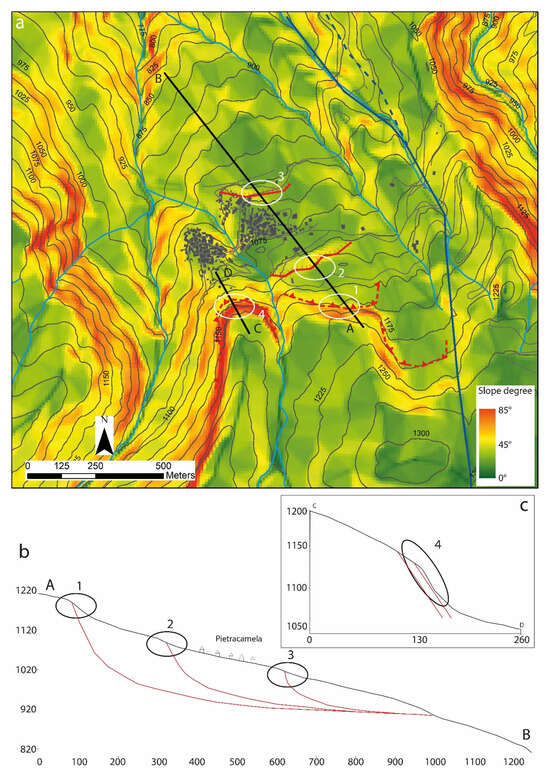
Figure 3.
(a) Slope Map and profile section traces A–B and C–D. (b) Slope profile A–B. (c) Slope profile C–D.
Based on this interpretation and borehole data, A–B and C–D geological sections have been developed, highlighting landslide geometry. Figure 4 shows the geological sections A–B (with a simplified representation of borehole data) and C–D.
4.2. UAV and Geomechanical Analysis
Field surveys have been undertaken through conventional and UAV analyses. The UAV-extracted 3D model of the Pietracamela area gathered through SfM algorithms, is shown in Figure 5.
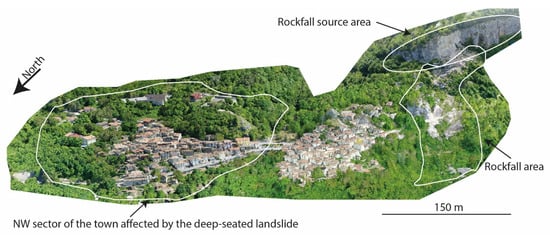
Figure 5.
UAV extracted a 3D model of the Pietracamela area with a view toward the south. White poligons show the rockfall area is the area affected by the 2011 rockfall event, the rockfall source area from which the blocks failed, and the NW sector of the village, affected by a deep-seated landslide.
In this figure, it has been highlighted that the NE sector of the village is characterized by deep-seated movement, and the SW sector is potentially affected by rockfalls. The rockfall source area illustrated in the model is the Capo le Vene cliff, while the rockfall area is affected by the 2011 rockfall event. Such an event has been analyzed through orthophotos (from 2010), Google Earth images (from 2017), and UAV photographs to highlight the characteristics of the failure and its volumes. Figure 6 shows the photographs of pre- (a) and post- (b) events. Figure 6c shows the block volumes and the area affected by rockfalls (white polygon). Block volumes, defined in the UAV-extracted 3D model measuring their perimeter and thickness, range from a few cubic meters (12 m3) to ca 1500 m3.
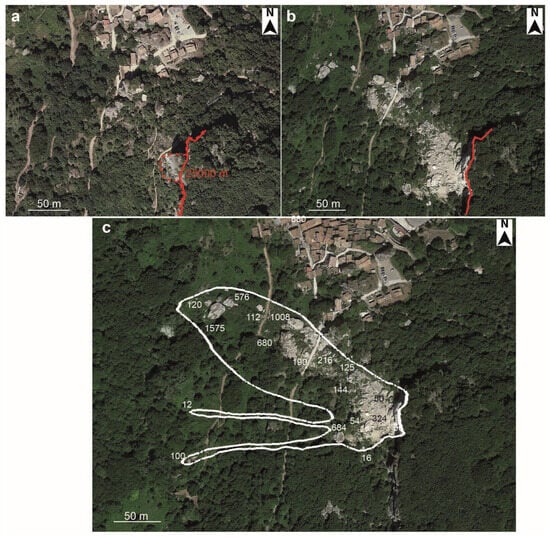
Figure 6.
Orthophoto (2010) pre- (a) and Google Earth image (2017) post- (b) rockfall events and (c) block volumes within the area affected by the 2011 rockfall event (white polygon) calculated using the orthophotos and the UAV-extracted 3D model.
The analysis of engineering–geological and UAV data highlighted the presence of three main discontinuity sets characterized by a high dip angle (sub-vertical) and oriented to the east, north, and northeast. The geometry of the three sets, in terms of dip and dip direction, is reported in Table 1. Figure 7 shows a detail of the Capo le Vene cliff. In particular, Figure 7a highlights the 3D model in RGB colors; Figure 7b shows the same 3D model analyzed in the CloudCompare (v. 2.12.4) software, with a color scale indicating the slope and discontinuity face dip direction. Figure 7c reports the stereonet of the discontinuity sets.

Table 1.
Geometry of the three discontinuity sets.
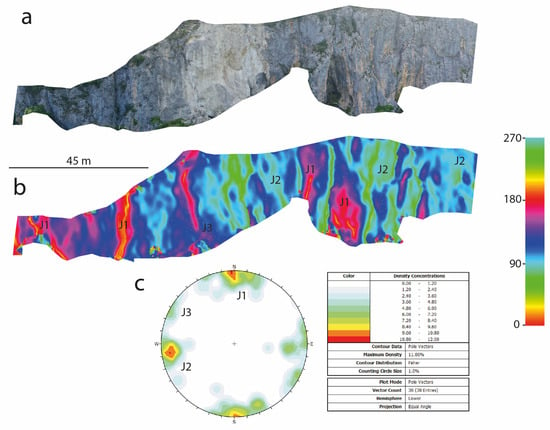
Figure 7.
UAV-extracted 3D model and joint sets characterizing Capo le Vene cliff. (a) 3D model in RGB colors. (b) A 3D model with a color scale indicating the slope and discontinuity face dip direction (°). (c) Stereonet of the discontinuity sets.
Considering that in the area affected by the 2011 rockfall event, the slope has an orientation ranging from NS to NNE-SSW, the joint set J2 and J3, with a similar orientation, played a key role in the slope failure (line A–B in Figure 4).
4.3. DInSAR Analysis
A historical analysis of the displacement rates recorded in the built-up area of Pietracamela was carried out by consulting the data available on the National Geoportal of the Ministry of the Environment (MoE—http://www.pcn.minambiente.it/mattm/, accessed on 11 June 2024) and additional 195 SAR images from the SENTINEL-1 acquired in the framework of the COPERNICUS project of ESA. In detail, displacements measured from ERS1/2 images for the period 1992–2000 are represented in the green rectangle, from ENVISAT images for the period 2002–2010 in the yellow one, from COSMO-SkyMed images for the period 2011–2014 in the orange one, and, finally, from SENTINEL-1 images in the red rectangle. It is possible to observe in the mean LoS displacement rate maps in descending orbit from ERS1/2 (Figure 8a), ENVISAT (Figure 8b), COSMO-SkyMed (Figure 8c), and SENTINEL-1 (Figure 9) that the northern sector of the settlement has always been characterized by significant displacement rates, while the southern sector has been substantially stable for the entire period analyzed. Points P1, P2, and P3 in Figure 8a,b,c, respectively, represent the feature points selected for displacement time series analysis in Figure 10.
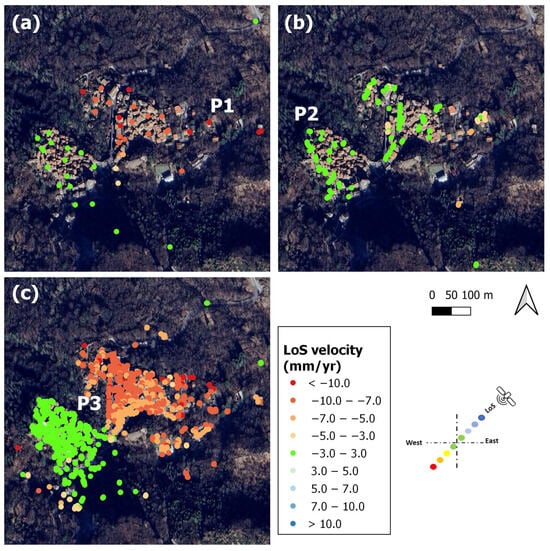
Figure 8.
Mean LoS displacement rate maps in descending orbit: (a) ERS1/2; (b) ENVISAT; (c) COSMO-SkyMed. Legend shows the rate and direction of displacement. Points P1, P2, and P3 are the feature points selected for displacement time series analysis in Figure 10.

Figure 9.
Mean displacement rate map for SENTINEL-1 (time span 2016–2019) descending images.
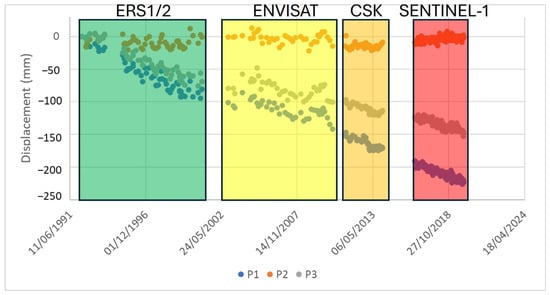
Figure 10.
Time series of displacement: ERS1/2 (green box); ENVISAT (yellow box); COSMO-SkyMed (orange box); SENTINEL-1 (red box).
From the analysis of P1, P2, and P3, it is possible to observe that P2 does not show evidence of displacement (southern sector of the village), while P3 and P1 (northern sector) present a linear displacement trend with displacements up to about 150 mm (P3) and 230 mm (P1), respectively (about 1 cm/year for P1).
5. Discussion
The Pietracamela village represents a peculiar case study since its urban area is affected by two different landslide phenomena. The NE sector of the village is characterized by a slow, deep-seated movement, while the SW sector is characterized by rockfalls. The stability has been analyzed through borehole data and DInSAR analysis. Borehole data highlight that the village is built on top of three main geological units. From the bottom to the top, we can find the Marne con Cerrogna Formation, Marne a Pteropodi, and Laga Formation. On top of the Laga Formation, a few meters of landslide/eluvial deposits are present.
With regard to the use of DInSAR, this was useful, on the one hand, to better understand the area affected by the deep-seated landslide (combined with GIS analysis), confirming what was found in previous studies. On the other hand, this analysis played a key role in evaluating, over a time interval of about 30 years, the displacement rates. In the case of Pietracamela, the DInSAR analysis has shown the slow movement of the NE sector of the village, recording a displacement from 1992 to 2019 of ca 25 cm. The displacement trend is linear, demonstrating the long and constant activity of the landslide. The SW sector, which represents the historical part of the village, does not show evidence of displacement. Two main factors probably controlled the deep-seated movements. The first one is associated with the stratigraphy/geology of the area. The Marne a Pteropodi Formation, a 20–30 m thick and potentially impermeable layer (mainly clayey), which is between the Laga Formation and the Marne con Cerrogna, might host the most superficial failure surface (ca 30 m deep). Furthermore, the alternance of marls and marly limestones in the Marne con Cerrogna Formation creates the condition for deeper failure surfaces along the weaker marl layers. This is confirmed by the slow deformation measured in the early 1990s by an inclinometer at 160 m of depth (the inclinometer was dismissed many years ago).
This reconstruction agrees with the study carried out by Centamore et al. [], which confirmed the geomorphological setting of the area and the presence of a composite deep-seated landslide sliding in the Marne a Pteropodi and Marne con Cerrogna formations.
The second factor that may have had a role in the landslide triggering is represented by the ”Fosso Rio la Porta” stream, which divides the village into two sectors. The river erosion, along with the tectonic uplift that characterized the Apennines, played a key role in the morphological evolution of the area, generating the small “Fosso Rio la Porta” valley. Such erosion facilitated the lateral release of landslides affecting the NE sector of the village.
The presence of different failure surfaces in deep-seated phenomena and the role of gullies/river erosion in releasing deep-seated phenomena have been documented by several authors all over the world [,,,,]. An example has been recently shown by Francioni et al. [], who demonstrated the roles of gullies/river erosion in landslide movements and identified two main failure surfaces in the Alexandria landslides (CA) at 80 m and 100 m, respectively.
Regarding the SW sector of the village, this has been affected by rockfall events, with the last large event occurring in 2011. Rockfall source areas are represented by the “Capo le Vene” cliffs, a relief standing in the south of the village, characterized by the “Sintema di Pietracamela” Formation (the youngest formation cropping out in the area). The geomechanical study of the cliff was performed through conventional and UAV surveys. The use of UAVs played a key role in the analysis of inaccessible areas. Three main discontinuity sets have been found, characterizing the relief. The kinematic analysis of these highlighted the probable occurrence of planar and wedge failures along J2 or J3, and the analysis of rock block volumes highlighted the possibility that large blocks could detach from the cliff (blocks up to 1500 cubic m have been surveyed after the 2011 rockfall events). The combination of InSAR, UAV, and borehole data was fundamental in this research to better understand the behavior of the two completely different failure mechanisms affecting the village of Pietracamela and to develop a map highlighting the areas affected by these phenomena (Figure 11). It is important to state that, regarding the deep-seated landslide, the area affected by the movement was revealed using the InSAR data (as mentioned above) and GIS interpretation. The InSAR displacement was measured on buildings, while forested areas were not covered. It has to be highlighted that, between the different satellite data acquisitions, small gaps are present. In these cases, since the trend is linear for all the years investigated through the InSAR data, we also considered a linear deformation trend during the gap periods. Through the interpretation of orthophotos and GIS thematic maps (i.e., Hillshade, Slope, and Aspect maps), it was possible to define the landslide surface, main scarp, and secondary scarps (Figure 11). The presence of secondary scarps within the landslide body testifies to the possibility that the deep-seated landslide is characterized by multiple blocks, in accordance with the studies carried out by Centamore et al. []. Finally, it is important to note that in the Estern sector of the map, an earthflow is present. This phenomenon has been known for many years and, fortunately, does not affect the urban area. Therefore, this has not been part of this research.
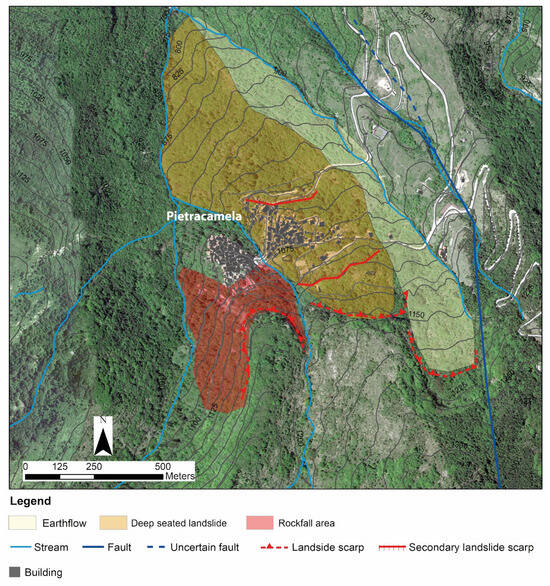
Figure 11.
Landslide map of Pietracamela was developed by combining InSAR, UAV, borehole data, and rockfall analyses. Red polygon shows the rockfall area, the orange polygon is the area affected by deep-seated movement, and the light yellow polygon is the earthflow located north of the village (the earthflow has not been analyzed in this research since it is not affecting the village).
6. Conclusions
The area of Pietracamela is simultaneously affected by two different landslide mechanisms. The NE sector of the village is characterized by a deep-seated landslide. The borehole data demonstrate that the weak “Marne a Pteropodi” layer and the alternance between weak marl and stronger marly limestone layers of the Marche con ”Cerrogna Formation” represent the main sliding surfaces of the landslide. This has also been measured in the past by an inclinometer (now dismissed), which recognized the deeper failure surface at 160 m depth. The DInSAR analysis confirmed that the landslide is slowly continuing its activity, with displacements ranging from 150 mm up to 230 mm in the last 30 years. This analysis also highlights that, unlike the NE sector, the SW sector does not show evidence of displacement. The two sectors of the village are separated by the ”Fosso Rio la Porta” stream, which, through its erosion process, facilitated the lateral release of landslides affecting the NE sector of the village. The presence of secondary scarps within the landslide body confirms the hypothesis of Centamore et al. [] that the deep-seated landslide might be characterized by multiple blocks.
Although the SW sector is not interested in the deep-seated phenomenon, it has been affected over the years by rockfall events generated from the “Capo le Vene” cliff on the south side of the village. During the last event, which occurred in 2011, large blocks (up to 1500 m3) detached from the cliff along the J2 and J3 discontinuity sets and failed close to the SW sector of the village. Considering the slope and discontinuity attitude, similar failures may occur in the future, and therefore, further analysis and simulation should be carried out in this area.
In this research, the combined use of different survey techniques played a key role in understanding the mechanisms and behavior of the two different landslide phenomena. The combined use of DInSAR and borehole data was important to better define the deep-seated phenomena, while UAV data and rockfall simulations were used to characterize the steep “Capo le Vene” cliff, calculate block volumes, and hypothesize potential rockfall areas.
The presented integrated approach and the use of multi-source InSAR data could be replicated by scholars and practitioners for the study of similar phenomena, improving our knowledge about landslide hazards and the definition of hazardous areas.
Author Contributions
Conceptualization, M.F., L.G., D.D.M., N.S., D.C. and G.S.M.; methodology, M.F., L.G., D.D.M. and N.S.; software, M.F., L.G. and D.D.M.; validation, D.C., G.S.M. and N.S.; formal analysis, M.F., L.G. and D.D.M.; investigation, M.F., L.G., D.D.M. and G.S.M.; data curation, M.F., L.G., D.D.M. and D.C.; writing—original draft preparation, M.F., L.G. and D.D.M.; writing—review and editing, G.S.M., N.S. and D.C.; visualization, M.F., L.G., D.D.M. and D.C.; supervision, G.S.M., N.S. and D.C.; project administration, M.F. and N.S.; funding acquisition, N.S. All authors have read and agreed to the published version of the manuscript.
Funding
This research received no external funding.
Data Availability Statement
The original contributions presented in the study are included in the article, further inquiries can be directed to the corresponding author.
Acknowledgments
The authors kindly thank the Pietracamela Village Municipality for providing permission to perform field tests. The authors thank the editors and the anonymous reviewers.
Conflicts of Interest
The authors declare no conflicts of interest.
References
- Glade, T.; Crozier, M.J. The Nature of Landslide Hazard Impact. In Landslide Hazard and Risk; Glade, T., Anderson, M.G., Crozier, M.J., Eds.; John Wiley & Sons, Ltd.: Hoboken, NJ, USA, 2005; pp. 43–74. [Google Scholar]
- Booth, A.M.; Lamb, M.P.; Avouac, J.P.; Delacourt, C. Landslide velocity, thickness, and rheology from remote sensing: La Clapière landslide, France. Geophys. Res. Lett. 2013, 40, 4299–4304. [Google Scholar] [CrossRef]
- Hungr, O.; Leroueil, S.; Picarelli, L. The Varnes classification of landslide types, an update. Landslides 2014, 11, 167–194. [Google Scholar] [CrossRef]
- Guerriero, L.; Bertello, L.; Cardozo, N.; Berti, M.; Grelle, G.; Revellino, P. Unsteady sediment discharge in earth flows: A case study from the Mount Pizzuto earth flow, southern Italy. Geomorphology 2017, 295, 260–284. [Google Scholar] [CrossRef]
- De Vita, P.; Carratù, M.T.; La Barbera, G.; Santoro, S. Kinematics and geological constraints of the slow-moving Pisciotta rock slide (southern Italy). Geomorphology 2013, 201, 415–429. [Google Scholar] [CrossRef]
- Pappalardo, G.; Mineo, S.; Angrisani, A.C.; Di Martire, D.; Calcaterra, D. Combining field data with infrared thermography and DInSAR surveys to evaluate the activity of landslides: The case study of Randazzo Landslide (NE Sicily). Landslides 2018, 15, 2173–2193. [Google Scholar] [CrossRef]
- Guerriero, L.; Prinzi, E.P.; Calcaterra, D.; Ciarcia, S.; Di Martire, D.; Guadagno, F.M.; Ruzza, G.; Revellino, P. Kinematics and geologic control of the deep-seated landslide affecting the historic center of Buonalbergo, southern Italy. Geomorphology 2021, 394, 107961. [Google Scholar] [CrossRef]
- He, L.; Coggan, J.; Francioni, M.; Eyre, M. Maximizing impacts of remote sensing surveys in slope stability—A novel method to incorporate discontinuities into machine learning landslide prediction. ISPRS Int. J. Geo-Inf. 2021, 10, 232. [Google Scholar] [CrossRef]
- Caliò, D.; Mineo, S.; Pappalardo, G. Digital Rock Mass Analysis for the Evaluation of Rockfall Magnitude at Poorly Accessible Cliffs. Remote Sens. 2023, 15, 1515. [Google Scholar] [CrossRef]
- Mammoliti, E.; Pepi, A.; Fronzi, D.; Morelli, S.; Volatili, T.; Tazioli, A.; Francioni, M. 3D Discrete Fracture Network Modelling from UAV Imagery Coupled with Tracer Tests to Assess Fracture Conductivity in an Unstable Rock Slope: Implications for Rockfall Phenomena. Remote Sens. 2023, 15, 1222. [Google Scholar] [CrossRef]
- Markus, S.J.; Wartman, J.; Olsen, M.; Darrow, M.M. Lidar-Derived Rockfall Inventory—An Analysis of the Geomorphic Evolution of Rock Slopes and Modifying the Rockfall Activity Index (RAI). Remote Sens. 2023, 15, 4223. [Google Scholar] [CrossRef]
- Morelli, S.; Bonì, R.; De Donatis, M.; Marino, L.; Pappafico, G.F.; Francioni, M. A Low-Cost and Fast Operational Procedure to Identify Potential Slope Instabilities in Cultural Heritage Sites. Remote Sens. 2023, 15, 5574. [Google Scholar] [CrossRef]
- Brückl, E.; Brunner, F.K.; Kraus, K. Kinematics of a deep-seated landslide derived from photogrammetric, GPS and geophysical data. Eng. Geol. 2006, 88, 149–159. [Google Scholar] [CrossRef]
- Frattini, P.; Crosta, G.B.; Rossini, M.; Allievi, J. Activity and kinematic behaviour of deep-seated landslides from PS-InSAR displacement rate measurements. Landslides 2018, 15, 1053–1070. [Google Scholar] [CrossRef]
- Di Martire, D.; Novellino, A.; Ramondini, M.; Calcaterra, D. A-Differential Synthetic Aperture Radar Interferometry analysis of a Deep Seated Gravitational Slope Deformation occurring at Bisaccia (Italy). Sci. Total Environ. 2016, 550, 556–573. [Google Scholar] [CrossRef]
- Guerriero, L.; Di Martire, D.; Calcaterra, D.; Francioni, M. Digital image correlation of google earth images for earth’s surface displacement estimation. Remote Sens. 2020, 12, 3518. [Google Scholar] [CrossRef]
- Notti, D.; Wrzesniak, A.; Dematteis, N.; Lollino, P.; Fazio, N.L.; Zucca, F.; Giordan, D. A multidisciplinary investigation of deep-seated landslide reactivation triggered by an extreme rainfall event: A case study of the Monesi di Mendatica landslide, Ligurian Alps. Landslides 2021, 18, 2341–2365. [Google Scholar] [CrossRef]
- Samsonov, S.V.; Blais-Stevens, A. Estimating volume of large slow-moving deep-seated landslides in northern Canada from DInSAR-derived 2D and constrained 3D deformation rates. Remote Sens. Environ. 2024, 305, 114049. [Google Scholar] [CrossRef]
- Stead, D.; Wolter, A. A critical review of rock slope failure mechanisms: The importance of structural geology. J. Struct. Geol. 2015, 74, 1–23. [Google Scholar] [CrossRef]
- Lacasse, S.; Nadim, F. Landslide risk assessment and mitigation strategy. In Landslides—Disaster Risk Reduction; Springer: Berlin/Heidelberg, Germany, 2009; pp. 31–61. [Google Scholar]
- Popescu, M.E.; Sasahara, K. Engineering Measures for Landslide Disaster Mitigation. In Landslides—Disaster Risk Reduction; Sassa, K., Canuti, P., Eds.; Springer: Berlin/Heidelberg, Germany, 2009. [Google Scholar]
- Galve, J.P.; Cevasco, A.; Brandolini, P.; Soldati, M. Assessment of shallow landslide risk mitigation measures based on land use planning through probabilistic modelling. Landslides 2015, 12, 101–114. [Google Scholar] [CrossRef]
- Centamore, E.; Nisio, S.; Prestininzi, A.; Scarascia Mugnozza, G. Evoluzione morfodinamica e fenomeni franosi nel settore periadriatico dell’Abruzzo Settentrionale. Studi Geol. Camerti 1997, 14, 9–27. [Google Scholar]
- Centamore, E.; Cantalamessa, G.; Micarelli, A.; Potetti, M.; Berti, D.; Bigi, S.; Morelli, C.; Ridolfi, M. Stratigrafia e analisi di facies dei depositi del Miocene e del Pliocene inferiore dell’avanfossa marchigiano-abruzzese e delle zone limitrofe. Studi Geol. Camerti 1992, 2, 125–131. [Google Scholar]
- D’agostino, N.; Chamot-Rooke, N.; Funiciello, R.; Jolivet, L.; Speranza, F. The role of preexisting thrust faults and topography on the styles of extension in the Gran Sasso range (Central Italy). Tectonophysics 1998, 292, 229–254. [Google Scholar] [CrossRef]
- Calamita, F.; Adamoli, L.; Scisciani, V.; Ben M’Barek, M.; Pelorosso, M. Il sistema a thrust del Gran Sasso d’Italia (Appennino Centrale). Studi Geol. Camerti Nuova Ser. 2002, 1, 19–32. [Google Scholar]
- D’alessandro, L.; De Sisti, G.; D’orefice, M.; Pecci, M.; Ventura, M. Geomorphology of the summit area of the Gran Sasso d’Italia (Abruzzo, Italy). Geogr. Fis. Din. Quat. 2003, 26, 125–141. [Google Scholar]
- Boncio, P.; Lavecchia, G.; Pace, B. Defining a model of 3D seismogenic sources for seismic hazard assessment applications: The case of central Apennines (Italy). J. Seism. 2004, 8, 407–425. [Google Scholar] [CrossRef]
- Calamita, F.; Patruno, S.; Pomposo, G.; Tavarnelli, E. Geometria e cinematica delle anticlinali dell’Appennino centrale esterno: Il ruolo delle faglie dirette giurassiche. Rend. Della Soc. Geol. Ital. 2007, 4, 167–169. [Google Scholar]
- Pecci, M.; D’Aquila, P. Geomorphological features and cartography of the Gran Sasso d’Italia massif between Corno Grande-Corno Piccolo and Pizzo Intermesoli. Geogr. Fis. Dinam. Quat. 2011, 34, 127–143. [Google Scholar]
- Gabriel, A.K.; Goldstein, R.M.; Zebker, H.A. Mapping small elevation changes over large areas: Differential radar interferometry. J. Geophys. Res. 1989, 94, 9183–9191. [Google Scholar] [CrossRef]
- Ferretti, A.; Prati, C.; Rocca, F. Permanent Scatteres in SAR Interferometry. IEEE Trans. Geosci. Remote Sens. 2001, 39, 8–20. [Google Scholar] [CrossRef]
- Sacco, P.; Battagliere, M.L.; Daraio, M.G.; Coletta, A. The COSMO-SkyMed constellation monitoring of the Italian territory: The Map Italy project. In Proceedings of the 66th International Astronautical Congress (IAC), Jerusalem, Israel, 12–16 October 2015; pp. 12–16. [Google Scholar]
- Barra, A.; Monserrat, O.; Mazzanti, P.; Esposito, C.; Crosetto, M.; Scarascia Mugnozza, G. First insights on the potential of Sentinel-1 for landslides detection. Geomat. Nat. Hazard Risk 2016, 7, 1874–1883. [Google Scholar] [CrossRef]
- Costantini, M.; Ferretti, A.; Minati, F.; Falco, S.; Trillo, F.; Colombo, D.; Novali, F.; Malvarosa, F.; Mammone, C.; Vecchioli, F.; et al. Analysis of surface deformations over the whole Italian territory by interferometric processing of ERS, Envisat and COSMOSkyMed radar data. Remote Sens. Environ. 2017, 202, 250–275. [Google Scholar] [CrossRef]
- Di Martire, D.; Paci, M.; Confuorto, P.; Costabile, S.; Guastaferro, F.; Verta, A.; Calcaterra, D. A nation-wide system for landslide mapping and risk management in Italy: The second Not-ordinary Plan of Environmental Remote Sensing. Int. J. Appl. Earth Obs. Geoinf. 2017, 63, 143–157. [Google Scholar] [CrossRef]
- Mora, O.; Mallorqui, J.; Broquetas, A. Linear and nonlinear terrain deformation maps from a reduced set of interferometric sar images. IEEE Trans. Geosci. Remote Sens. 2003, 41, 2243–2253. [Google Scholar] [CrossRef]
- Iglesias, R.; Mallorqui, J.J.; Monells, D.; López-Martínez, C.; Fabregas, X.; Aguasca, A.; Gili, J.A.; Corominas, J. PSI deformation map retrieval by means of temporal sublook coherence on reduced sets of SAR images. Remote Sens. 2015, 7, 530–563. [Google Scholar] [CrossRef]
- Alexander, D.; Formichi, R. Tectonic causes of landslides. Earth Surf. Process. Landf. 1993, 18, 311–338. [Google Scholar] [CrossRef]
- Larsen, I.; Montgomery, D. Landslide erosion coupled to tectonics and river incision. Nat. Geosci. 2012, 5, 468–473. [Google Scholar] [CrossRef]
- Lebourg, T.; Binet, S.; Tric, E.; Jomard, H.; El Bedoui, S. Geophysical survey to estimate the 3D sliding surface and the 4D evolution of the water pressure on part of a deep seated landslide. Terra Nova 2015, 17, 399–406. [Google Scholar] [CrossRef]
- Chang, K.T.; Huang, H.C. Three-dimensional analysis of a deep-seated landslide in central Taiwan. Environ. Earth Sci. 2015, 74, 1379–1390. [Google Scholar] [CrossRef]
- Carlini, M.; Chelli, A.; Vescovi, P.; Artoni, A.; Clemenzi, L.; Tellini, C.; Torelli, L. Tectonic control on the development and distribution of large landslides in the Northern Apennines (Italy). Geomorphology 2016, 253, 425–437. [Google Scholar] [CrossRef]
- Francioni, M.; Stead, D.; Clague, J.J.; Westin, A. Identification and analysis of large Paleo-Landslides at Mount Burnaby, British Columbia. Environ. Eng. Geosci. 2018, 24, 221–235. [Google Scholar] [CrossRef]
Disclaimer/Publisher’s Note: The statements, opinions and data contained in all publications are solely those of the individual author(s) and contributor(s) and not of MDPI and/or the editor(s). MDPI and/or the editor(s) disclaim responsibility for any injury to people or property resulting from any ideas, methods, instructions or products referred to in the content. |
© 2024 by the authors. Licensee MDPI, Basel, Switzerland. This article is an open access article distributed under the terms and conditions of the Creative Commons Attribution (CC BY) license (https://creativecommons.org/licenses/by/4.0/).
